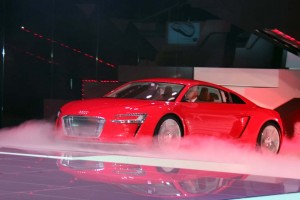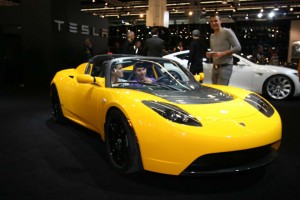In years past, the debut of the 2012 Mercedes-Benz SLS would have been something of the norm for the Frankfurt Motor Show. True, at a price of around $300,000, the supercar is far from the mainstream, but in keeping with the emphasis on technology and performance by the country that prides itself in the speed limitless Autobahn, muscle is normally a high priority.
There were certainly plenty of media on hand to witness the debut of the gullwinged SLS, which boasts a top speed of 197 mph. But the supercar took something of a backseat, even on the Mercedes stand, where the bulk of the German maker’s news conference focused on high-mileage models like the S500, a hybrid-electric version of its flagship S-Class sedan, and the F-Cell, a prototype crossover vehicle running on clean hydrogen.
“For me, the key message of this show is that we, as industry are delivering on the promise we made two years ago,” said Dr. Thomas Weber, technology chief for Mercedes’ parent, Daimler AG. At the 2007 Frankfurt show, he recalled, makers like Mercedes, “looked at where we would have to go to be sustainable.”
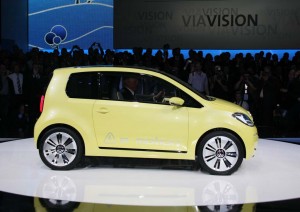
Should the industry focus on high-end electric vehicles, where consumers can afford the premium for the technology, or start with mini-EVs, like this Volkswagen e-Up prototype?
The European auto market began moving in the direction of cleaner, more fuel-efficient vehicles far sooner – and more quickly – than in the U.S., though that had as much to do with expensive gasoline as it did with issues like global warming. But the latter has been heating up the pace of the transformation – and dramatically shifting the sort of products manufacturers large and small see as critical to their future.
In 2007, the spotlight largely shone on diesels, which generally yield as much as 25% to 35% better mileage than gasoline powertrains.
This year, however, the buzzword is “electrification.” Indeed, it is hard to find a single manufacturer at the 2009 Frankfurt Motor Show, even those known for high-performance products, not showing some form of electric vehicle. Porsche, for example, is not only getting ready to launch its first hybrid-electric vehicle, a version of its Cayenne SUV, but announced, at the Frankfurt show, that it will develop a car running solely on batteries.
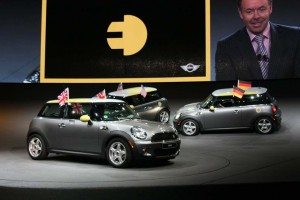
BMW's British subsidiary is running a year-long test of the capabilities of battery cars using its Mini-E.
Audi is another luxury maker pursuing electrification at a variety of levels. It also is readying hybrid offerings, but perhaps its biggest launch, at the show, was that of the e-tron, a battery-powered supercar. Capable of launching from 0 to 60 in just 4.8 seconds, about as fast as the maker’s R8 sports car, it is scheduled to go into limited production by 2012.
Why are high-line makers looking at producing expensive battery vehicles? “This is where the customer is most willing to pay a premium for this type of technology,” contends Audi CEO Rupert Stadler.
But there’s another, more practical reason. Regulators, around the world, are cracking down on emissions and pushing for marked improvements in fuel economy. At the BMW stand, for example, every model on display bore decals showing both its mileage and the amount of CO2 the vehicle produces.
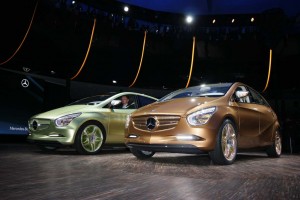
Mercedes is also looking at opportunities for Plug-in Hybrid and Fuel Cell Vehicle technology, used in its prototypes, the E-Cell Plus and the F-Cell.
Proposed European regulations will require manufacturers to reduce the amount of that global warming gas to about 120 grams per kilometer driven, though the rules will likely vary by manufacturer, reflecting each maker’s traditional model mix.
“Does sustainability mean we have to build small cars? Not necessarily,” cautioned Weber, pointing to the S500 Blue Efficiency sedan Mercedes unveiled during its Frankfurt news conference.
The plug-in hybrid will be able to charge up from either a standard household outlet or dedicated, high-voltage charger, and drive moderate distances solely on battery power. For longer trips, it will operate as a conventional hybrid, using its battery system to deliver overall fuel economy close to what far smaller vehicles get today.
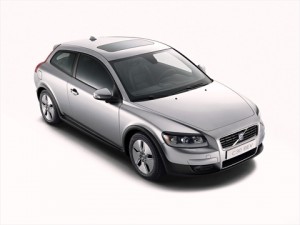
Virtually every major maker -- and some minor ones -- are entering the battery car field, including Volvo, which has announce a BEV version of its C30.
But most makers are embracing the idea of downsizing, whether with conventionally-powered vehicles or those using battery powertrains. That includes Volkswagen, which intends to start selling a version of its e-Up battery-electric vehicle, or BEV, by 2013. It’s based on the Up, the smallest car in the VW line-up, though Dr. Ulrich Hackenberg, the maker’s technology director, said that a “slightly larger” version would likely be offered in the American market.
The massive U.S. market is essential to pushing electric powertrain technology into the mainstream, assets Elon Musk, the high-tech billionaire and founder of the Silicon Valley start-up Tesla Motors.
Only a few years ago, skeptics – and there were many – dismissed the Israeli-born executives venture, which initially focused on a high-powered BEV sports car, the Tesla Roadster. Now, he is as likely to be declared a visionary. But Musk’s company is ready to move on from what he admits was more a demonstration project than the start of a real, electric vehicle revolution.
With a mix of private funding and federal dollars, Tesla is rapidly developing the Model S, a stylish, midsize family sedan that the company hopes could reach volumes of 30,000 or more annually. The $57,400 price tag still isn’t quite in the mainstream, but it will qualify for federal tax credits that would drop that to $49,900, noted Musk, adding that if gasoline prices again surge to $4 or more a gallon, the savings on fuel would make it “pretty affordable” when you factor in the purchase price and day-to-day operating costs.
Taking battery vehicles into the mainstream is something industry suppliers are also hoping for. Right now, electrification is an expensive goal. Makers like Ford, Daimler, Toyota and even little Tesla are dropping billions into product development. Suppliers like Borg-Warner are investing sizable fortunes of their own developing the necessary components. But in low volumes, it’s difficult for them to recover that investment, certainly not when it is producing each of the transmissions for the Tesla Roadster by hand in its research lab, noted a senior Borg executive.
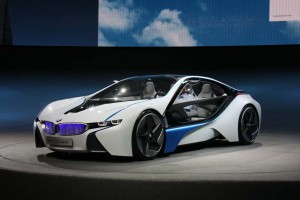
One of the challenges is to decide whether to go with a pure battery car, a plug-in, an E-REV or something even more unusual, like BMW's Vision Concept, with its diesel-hybrid powertrain.
Volume, industry officials agree, will be critical to making the most important part of the electrical vehicle – the battery itself – both more affordable and more competitive with the time-tested internal combustion engine.
“The battery defines the car,” said VW’s Hackenberg, but right now, that definition is one with relatively severe limits. Not only are today’s batteries expensive, but they offer only moderate vehicle range and require long charging times. That’s why some makers, notably including General Motors, have sought alternatives to pure battery vehicles.
At Frankfurt, the company’s German unit, Opel, showed a nearly production-ready version of its Ampera, a close cousin of the Chevrolet Volt Extended-Range Electric Vehicle. Similar to a plug-in, both Ampera and Volt will get about 40 miles on a charge before their gasoline engines kick in, allowing a motorist to keep going. The difference is that those internal combustion engines will only serve as a generator. Like a BEV, the wheels of Ampera and Volt can only be driven by their electric motors.
Whether plug-in, E-REV or pure battery-electric vehicle, the switch to electrification will be far more demanding than the expansion of diesel power. And it will directly affect consumers as well as manufacturers, who will see wholesale changes in their design, engineering and production operations.
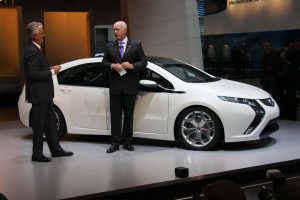
Every little bit matters. When engineers took the basic platform from the Chevy Volt and turned it into the Opel Ampera, they boosted range by reducing the weight of the E-REV's wheels.
Motorists will likely face higher prices, at least up front, though per mile operating costs could come down sharply. Using off-peak power, it could cost as little as a penny a mile to run a vehicle like e-Up.
But where to get that power? One could always plug into a household electric outlet, though dedicated high-voltage chargers are the preferred option, as they would reduce charging time on, for example, the e-tron, from 10 hours to two.
While consumers will be encouraged to purchase such chargers, the industry also knows it must provide a network of the devices, much as filling stations are needed to permit today’s drivers to travel long distances.
Earlier this month, a consortium of manufacturers, including Mercedes, BMW, Volkswagen and Toyota, as well as energy suppliers like Shell, announced they would greatly expand the network of hydrogen fueling stations that has been set up to support development of fuel cell vehicles. Significantly, they also agreed that the stations would add high-power chargers for battery vehicles. The goal is to jump from 30 to 60 such stations by 2012, but before the decade is out, there could be more than 1,000, making it possible for users of alternative power, whether hydrogen or electricity, to travel anywhere in Germany almost as easily as those running on gasoline or diesel.
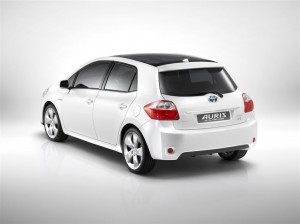
Toyota took an early lead in green technology and is struggling to maintain its reputation. It introduced a plug-in hybrid version of the Prius, in Frankfurt, and this Auris Hybrid concept.
Even so, most of the experts interviewed at the Frankfurt Motor Show cautioned that electrification will be a slow process.
“We will start with 10, then 100, then 1,000” vehicles, said Audi’s own technology director, Michael Dick. “The common thinking,” adds Audi’s global sales chief, Peter Schwarzenbauer, is that “It will take until 2030 to have half of the market go electric.”
That is, of course, just an estimate. Nobody really knows. There are so many uncertainties about the technology that it’s also possible it simply won’t work. But considering the pressure to find a clean alternative to the internal combustion engine, no one is willing to risk that possibility and sit on the sidelines – as is obvious by the cars on display at this year’s Frankfurt Motor Show.

